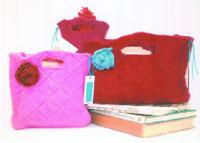
Carded, needled and quilted felt handbags, courtesy of Deanna Wood
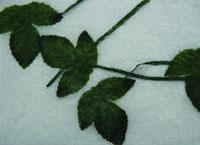
Artificial flowers needled to carded and needled felt for use in handbags, courtesy of Michelle Ritondo
|
Creation and Evolution Of A Nonwovens Design Course
By Brian George
School of Engineering and Textiles
Philadelphia University
Philadelphia University, formerly Philadelphia College of Textiles & Science, has long had nonwovens courses for undergraduate and graduate students enrolled in the technical textile degrees. Additionally, the university has a nonwovens lab that contains carding, air laid and wet laid web forming equipment and thermal, latex and needlepunch bonding equipment. The university also has various design programs, including textile design, fashion design and industrial design.
Starting in 2000, textile design students informally began investigating nonwovens as materials to be utilized in their portfolios. Previously, students utilized already manufactured fabrics or nonwovens purchased at fabric stores and explored methods of producing three-dimensional materials using fabric, heat and pressure. Students progressed to creating their own fabrics usually via carding and needling of wool and other fibers, and then manipulated the fabric to obtain the products desired.
At this point, several design students began taking the nonwovens course. As the course was designed for technical majors, the design students often commented that they would like more hands-on experience in the lab and with the fabrics subsequently produced in the lab. Therefore, Brittany Wittman, a former textile design professor, and myself, a textile engineering professor, created a course titled Nonwovens Fabrication and Design, which addressed these issues. The course, open to any design student, would provide students with an overview of nonwovens, as well as hands-on lab experience. With two professors from different backgrounds involved in the teaching of the course, students would gain technical understanding of nonwovens production and machine capability, in addition to feedback on different design techniques.
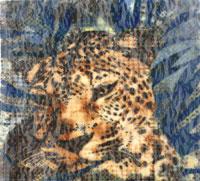
Fashion student Lauren Bertrando created carded needled, and printed felt for use as shoe coverings |
The course was first conducted during the spring 2005 semester with an enrollment of seven enthusiastic students from various design disciplines. Initially, the course was primarily lecture based, as the students learned the characteristics of different fibers, web forming methods, and bonding methods. As the class progressed, it became more lab-based, ending with all lab sessions by the end of the semester. Initially, students worked with the lab equipment to understand the various web forming and bonding processes as well as to determine the characteristics of the basic fabrics. From there, the students started experimenting, using various fiber types, fiber colors and non-traditional materials to determine what types of design could be incorporated into the web forming process, such as producing colored stripes during carding or random colored areas during the air laid process. Students also experimented with adding design into the bonding process by varying heat, pressure and bond points for thermal bonding, needle type and penetration during needlepunching and using different latexes and adding color during latex bonding.
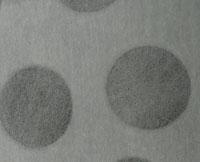
Carded and needled felt needled to thinner spunbond for use in lampshades was created by architecture major Tara Stasik |
The students were given a final project, which was to design a durable consumer product that included nonwoven fabric for a specific market. In most cases, the students not only designed a product, but created the component fabrics as well, often utilizing several fabrics produced with a variety of web forming and bonding processes. Generally. the students focused on products within their major. For example, fashion designers created accessories and footwear coverings, while an architecture major produced lamp shade fabrics, and a textile designer made fabrics for use in bedding accessories.
Other students explored variations on existing products. An industrial designer created a brassiere cup from nonwoven fabric with the idea that it would not contain seams, and would abrade away with use, thus alerting its owner that it needed to be replaced. Another textile design student created a line of disposable wipes to be used by consumers to relieve various pains. Finally, a textile design student explored the creation of nonwoven wall coverings that utilized a blend of recycled plastic store bags and bicomponent fibers.
Overall, the class was deemed to be a great success, as the students not only were successful in utilizing nonwovens in various products, but left the class with a newfound appreciation of materials few of them were familiar with prior to the start of the class. Additionally, the students successfully demonstrated the ability to incorporate design into the production of nonwovens, either through blending of fibers or colors, variations in bonding and/or printing. The students expressed satisfaction with the course in the course evaluation, but many also expressed a desire to have less lecture time and more hands-on and lab time.
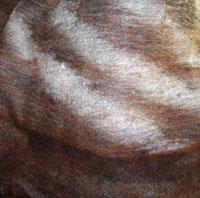 |
This course was repeated during the spring 2006 semester, with EJ Herczyk assuming the role of design professor. One student formally enrolled in the course and was joined by two students who took the course in 2005 and wanted to continue their work with nonwoven fabrics. The enrolled student spent the majority of her time in lab learning about the equipment and its capabilities, as well as exploring several design possibilities. Her final project was to create aesthetically pleasing sound absorption fabrics to be used in loud areas, such as restaurants and theaters. One of the returning students utilized nonwoven fabric in the creation of a back support for pregnant women, while the other created several nonwoven carpet pieces utilizing carded and needled felt containing either integral design in the form of color variations, needle variations, or other materials needled to the felt.
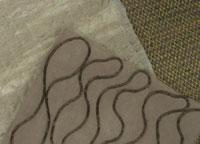 |
Working with design students on producing novel nonwoven fabrics during the past few years has increased my awareness of the role that design can play in the field of nonwovens. Teaching a combined nonwovens production and design class for the past two years has been exciting. The students and I have attempted different manners of incorporating design into web forming, bonding and finishing, sometimes with mixed results, but eventually resulting in successful product designs that contain elements not traditionally found in nonwoven fabrics or products. A class such as this has the potential to introduce new people to the field of nonwovens and generate ideas that could lead the way to innovate products or alternative designs for existing products. A team taught course involving both technical knowledge and design foundations along with a positive, experimental attitude provides students with enthusiasm not only for the class and their work but for nonwovens as well.

